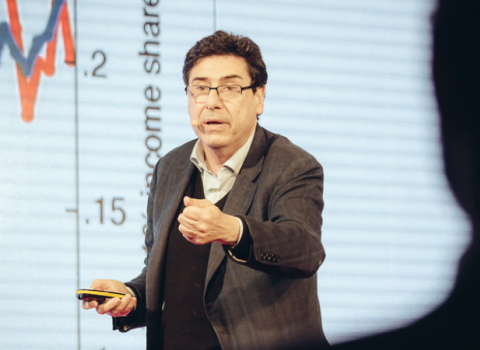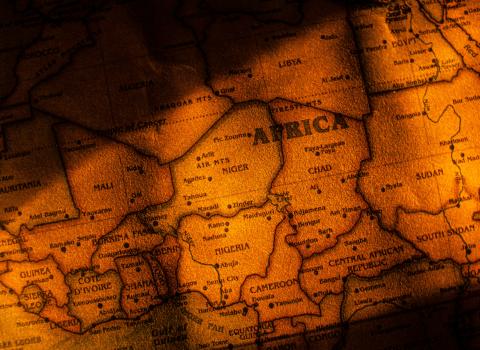In one apocalyptic moment on the afternoon of March 11, 2011, the Great Tōhoku Earthquake sent a giant tsunami wave sweeping over the city of Sendai, a peaceful metropolis of one million people in Northern Japan. The waves swept away vehicles, causing buildings to collapse and severing roads and highways. Debris swamped the city’s airport. The extent of the damage surprised even the most sophisticated of observers. To date, it has been difficult to nearly impossible to measure tsunamis or model defenses against it.
A new European Research Council backed tsunami simulator is filling this crucial gap. It's the brainchild of Tiziana Rossetto, an Italian-born professor of earthquake engineering at University College in London, who has spent her career trying to gain a greater understanding of these destructive waves.
Rossetto’s journey began back in 2004 when she visited Sri Lanka, which had just been hit by the giant Indian Ocean earthquake and tsunami. The visit made her realize that no good models existed for predicting the building damage from tsunamis. As a trained structural engineer, Rossetto believed it would be possible to transfer the advances made in protections against earthquake damage to protection against giant waves.
Scientists have long been able to create numerical models for how a tsunami travels from its source to the coastline. Much less is known about the way tsunamis spill over onto land, and their impact on different infrastructure both as the wave comes in, and as it retreats.
Traditional wave generating machines cannot reproduce the long wavelengths associated with tsunamis and only create waves which last for two minutes, while real-life tsunamis have a wave period of 20 to 40 minutes.
In order to fill this gap, Rossetto’s team has built the largest tsunami simulator in Europe, 70 meters long and four meters wide, enabling researchers for the first time to simulate a tsunami’s impact on urban areas. The goal is to provide engineering guidance on how to construct coastal infrastructure to withstand or mitigate their effects. As Rossetto notes, coastal cities are densely populated. “We’re inhabiting coastlines more and more,” she says. We need to do more to protect our populations and our assets.

Dr. Rossetto 's tsunami wave simulator in action (Credit: TheDailyEngineer.com)
After a tsunami disaster, cities often seek to pour more concrete around the coast, building seawalls and other flood barriers. Japan plans to build a 400-kilometre chain of sea walls to block any future waves, for instance. But creating new seawalls is controversial—and may not be the right answer. Japan’s new wall quickly received the nickname, ‘The Great Wall of Japan’.
There is limited evidence for the overall effectiveness of seawalls. A concrete shield may only divert damage away to another less protected site. While it may temporarily keep sloshing flood water at bay, the walls allow the water to build up and rash over a wall, intensifying its destructive power. This happened in Japan in 2011: after the seawalls at Sendai broke, a deluge of foamy water was released into the inundation zone, magnifying the destruction.
Another idea is to slow down the speed of the wave and absorb the energy of a tsunami by planting mixed forests along the coasts on tall mounds of soil or rubble. “Mangroves were observed to be helpful during the 2004 Indian Ocean tsunami,” said Rossetto. “But it’s not scientifically proven. If I had to guess now I’d say they make absolutely no difference.” A truly resilient approach to mitigating and managing the tsunami’s impact requires a multi-faceted approach.Dr. Rossetto speaking about key aspects of her research at a TEDxBrussels
Rossetto’s work goes beyond engineering – she was recently awarded a new European Research Council grant for her project URBAN WAVES, which aims to develop new science and techniques to holistically evaluate earthquake and tsunami risks and provide engineering guidance for their effective mitigation. It involves collaboration with psychologists to look at the perception of earthquake risk, in order to understand why people who live in seismic areas are unprepared for future events and, with this knowledge, design an intervention strategy.
This research is being used by insurers to assess tsunami risk analyses for UK and Japanese sites. In the recent decade five major tsunamis have wrought havoc, killing nearly 300,000 people and devastating large parts of Indonesia, India and Japan. Though more data and research will not necessarily prevent additional cataclysmic destruction, it’s an important start to building effective defenses.
This article is part of the ERC=Science² campaign that spotlights European Research Council-funded researchers who are chasing the next eureka moment.





 A unique international forum for public research organisations and companies to connect their external engagement with strategic interests around their R&D system.
A unique international forum for public research organisations and companies to connect their external engagement with strategic interests around their R&D system.